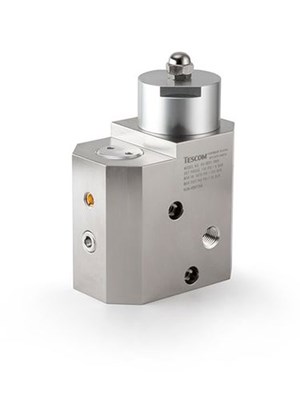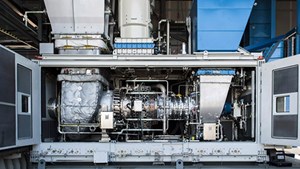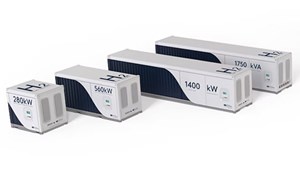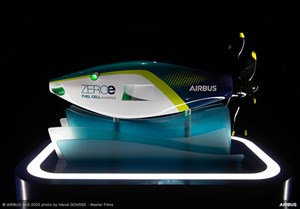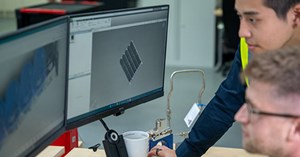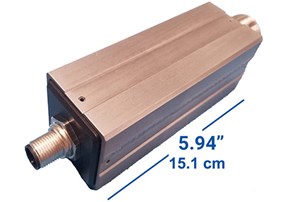Articles
H2Tech: Technology Spotlight
T. CAMPBELL, Managing Editor
H2 EQUIPMENT
ControlRooms launches observability platform to help chemical and energy producers increase uptime
ControlRooms has launched an artificial intelligence (AI)-powered observability platform for chemical and energy producers, and has announced its selection and deployment by OCI N.V., a leading global producer and distributor of H2-based products. OCI is utilizing ControlRooms’ AI technology in its U.S. methanol and ammonia plants to provide end-to-end observability of production. The ControlRooms platform enhances safety and efficiency, reducing downtime, costs and emissions.
With ControlRooms, operators and engineers can improve troubleshooting and achieve true observability of their operational data. ControlRooms uses advanced AI to highlight the trends that matter and identify anomalies across plant systems. Unlike other AI solutions, ControlRooms is quick to set up, designed for operators and can deliver value in minutes.
Emerson’s pressure-reducing regulator improves H2 fuel cell system performance in commercial vehicles
Emerson has launched a pressure-reducing regulator specially designed for use onboard commercial H2 fuel cell vehicles. The dual-stage and patented active seal design of the TESCOM™ HV-3500 Hydrogen Onboard Regulator delivers steady pressure and constant H2 fuel supply to fuel cells in the full range of vehicle operating conditions, including acceleration, deceleration, stopping and idling. Stable pressure aids in extending fuel cell life and maximizing fuel usage.
The reliable fuel pressure provided by the HV-3500 allows operators to drive farther without refueling and decreases the risk of over-pressurization downstream, which can result in leakage, wasted fuel and potential emissions. The HV-3500 has been designed, engineered and independently tested to ensure compliance with EC79 requirements for pressure regulators used in H2 vehicles.
By boosting fuel cell efficiency and maximizing overall energy efficiency, the stable pressure provided by the HV-3500 also reduces maintenance frequency. The regulator delivers positive high-pressure fuel shutoff of H2 in vehicles across varying road and operating conditions, increasing fuel cell durability.
The HV-3500 also helps original equipment manufacturers (OEMs) increase profitability by reducing manufacturing time and costs. Its dual-stage design eliminates the need for extra fittings and simplifies installation, while its square shape allows OEMs to secure it to existing panels and frames in the fuel cell system. The specially designed shape and mounting holes make the lightweight HV-3500 quicker and easier to install than other pressure regulation technologies. The reduced assembly time lowers installation costs.
Snam and Baker Hughes complete the first trial for the use of H2 as fuel in a gas compression station
Snam has completed a series of tests to experiment with using H2 as a fuel to power gas turbines at one of its natural gas compression stations in Istrana, Italy. The experiment, which was the first of its kind globally and carried out in collaboration with energy technology company Baker Hughes, demonstrated the compatibility of the various assets using a blend of H2 (at 10%) and natural gas.
The Istrana plant is one of 13 compression stations along Italy’s gas transportation network, with the function of boosting gas to help it travel through pipelines toward various consumption points across the country. This is the first Italian compression station in which a H2-ready turbine—the NovaLT12, designed and built by Baker Hughes in its Italian plants—has been installed. The tests also involved another Baker Hughes turbine already in operation in the plant, the PGT25, designed for operation with natural gas, which was tested for the first time using a blend of natural gas and H2 (at 10%). Between boosting and storage stations, Snam has 39 PGT25 turbines installed out of 73 machines, which account for about 70% of its total power capacity (1,325 MW).
The introduction of H2 in increasing quantities in the current fleet (from the 10% blend tested up to volumes between 15% and 20%) will allow for a greater reduction in CO2 emissions than natural gas alone. Based on operating data for 2021, the permanent use of 10% of H2 in all Snam group PGT25 turbines would make it possible to avoid almost 20,000 tpy of CO2 emissions, further reducing the already limited environmental impact of the natural gas supply.
Snam plans to continue collaborating with turbine suppliers to extend H2 compatibility tests to its entire turbocompressor fleet. The investigations in progress aim to verify the reaction of the various components from a metallurgical point of view, the required maintenance and efficiency of the turbines in the presence of H2, and compliance with stringent safety and environmental impact requirements. In the future, these tests could develop a consistent standard for the design of all future compression units used by Snam.
Snam and Baker Hughes, the company's partner in both the supply of the new NovaLT12 turbine and the field test activities, carried out the tests. The latter also involved Saipem and Max Streicher as technology partners and Siad, which supplied the H2.
EODev launches a range of high-power H2 generators
EODev, a French developer and manufacturer of zero-emissions electro-H2 power generators, has announced the commercialization of packaged solutions over the entire power range, from 10 kVA–1,750 kVA. The first models of this new range will enter production in 2024 and be available in 1H 2023.
EODev is now deploying a complete offer of carbon-free electricity production when the standard grid supply is non-existent, faulty or limited. The objective is to avoid the emissions of 30 MMt of CO2 over the next 10 yr.
On land. The new high-power GEH2 modules are available in two complementary models, which can be combined to adjust the offer to the needs: a 20-ft container version of 350 kVA and a 40-ft container version of 1,050 kVA. This range is completed by a 280-kW module specifically designed for EV charging in a 20-ft container, as well as a modular 10-kVA "Mini" GEH2® to meet the needs of the telecoms industry or to be used as network backup for the residential market during outages resulting from natural disasters or tensions on the grid.
The high power provided takes on its full meaning for highly sensitive applications such as energy security for industrial and airport facilities, hospitals, water treatment plants, data centers or even for power plant peak shaving; this includes applications already covered by the 110-kVA GEH2 on construction sites—as demand is already strong for the new 350-kVA GEH2.
At sea. The 2nd generation of the REXH2—in the process of type approval certification—paves the way for the development on the same bases of three more powerful modules ranging from 280 kW (10-ft container) to 1,400 kW (40-ft container) with a 20-ft container version of 560 kW in between. Designed to operate in parallel, these three new REXH2 will meet the needs of large and highly energy-intensive vessels, particularly cargo ships such as the upcoming Energy Observer 2.
The arrival of the REXH2 in an 8-kW version is intended to help decarbonize most of the fleet of recreational boats and meet the growing demand for small motorboats and sailboats to be zero emissions.
H2 STORAGE AND TRANSPORTATION APPLICATIONS
Airbus reveals H2-powered zero-emissions engine
Airbus is developing a H2-powered fuel cell engine. The propulsion system is considered one of the potential solutions to equip its zero-emissions aircraft that will enter service by 2035. Airbus will begin ground and flight testing this fuel cell engine architecture onboard its ZEROe demonstrator aircraft towards the middle of the decade. The A380 MSN1 flight test aircraft for new H2 technologies is being modified to carry liquid H2 tanks and their associated distribution systems.
H2 can be used as a power source for aircraft propulsion in two ways: first, via H2 combustion in a gas turbine; and second, by using fuel cells to convert H2 into electricity to power a propeller engine. A H2 gas turbine can also be coupled with fuel cells instead of batteries in a hybrid-electric architecture.
H2 fuel cells increase their power output, especially when stacked together, allowing scalability. In addition, an engine powered by H2 fuel cells produces zero nitrous oxide emissions or contrails, offering additional decarbonization benefits.
Luxfer Gas Cylinders receives certification for H2 storage safety technology
Following a rigorous testing regime, a range of H2 cylinders and systems from gas storage specialists Luxfer Gas Cylinders is now approved for Regulation No 134 (R134), an international certification for H2 cylinder manufacturers, amplifying the organization’s focus on high quality and safety values.
Luxfer’s H2 fuel storage systems provide development opportunities for alternative fuel vehicles. Achieving this safety regulation demonstrates that Luxfer’s high-performance cylinders and systems are safe for use in H2-powered vehicles across a wide range of applications.
H2 PRODUCTION
ENGIE Solutions completes the first tests for the power-to-H2-to-power HYFLEXPOWER demonstrator
ENGIE Solutions, Siemens Energy, Centrax, Arttic, the German Aerospace Center and four European universities—together forming the HYFLEXPOWER consortium—have announced the successful completion of the first stage of an innovative research project on renewable energy. Located at the Smurfit Kappa Saillat Paper Mill in Saillat-Sur-Vienne (France), this program has become the first industrial facility in the world to introduce an integrated H2 demonstrator.
The HYFLEXPOWER project aims to demonstrate that green H2 can be a flexible means of storing energy that can then be used to power an industrial turbine. The H2 is produced onsite with an electrolyzer and used in a gas turbine mix of 30 vol% H2 and 70 vol% natural gas for power generation.
The project marks the implementation of the world’s first industrial-scale, power-to-X-to-power demonstration with an advanced turbine with high H2 content fuel. In 2023, trials will continue to increase the H2 ratio to 100%.
While the large-scale availability of green H2 is still developing, the consortium members are focused on looking beyond 2030 and trialing new technology, such as H2. This project will allow the partners to understand the technical feasibility of using H2 while retaining much of the existing energy infrastructure, and this demonstrator will open great perspectives for the industry.
NuScale Power to develop and assess a concept for an economically optimized integrated energy system for H2 production
NuScale Power, Shell Global Solutions and industry participants will develop and assess a concept for an economically optimized integrated energy system (IES) for H2 production using electricity and process heat from a NuScale VOYGR™ small modular reactor (SMR) power plant. The project, “Development and demonstration of a concept for an economically optimized IES,” will be completed in two phases. Additional research participants include Idaho National Laboratory, Utah Associated Municipal Power Systems, Fuel Cell Energy, FPoliSolutions and GSE Solutions.
NuScale’s flexible SMR technology holds the potential to balance and stabilize power grids dominated by renewable energies through H2 production. Energy markets present reliability concerns when energy demand is high and renewable energy production is low. In these markets, H2 would be used as an end-product or as a stored energy source to be processed through a reversible solid oxide fuel cell (RSOFC) for electricity generation.
A NuScale control room simulator will be modified to evaluate the dynamics of the IES and will include models for the solid oxide electrolysis cell (SOEC) system for H2 production and an RSOFC for electricity production. The research will consider the number of NuScale Power Modules™ needed for SOEC H2 production and the quantity of H2 stored for subsequent electricity production. Further, local economic factors from the UAMPS Carbon Free Power Project will be assessed, such as the impact on the Western Energy Imbalance Market, resource adequacy programs, and other local market factors to be defined.

